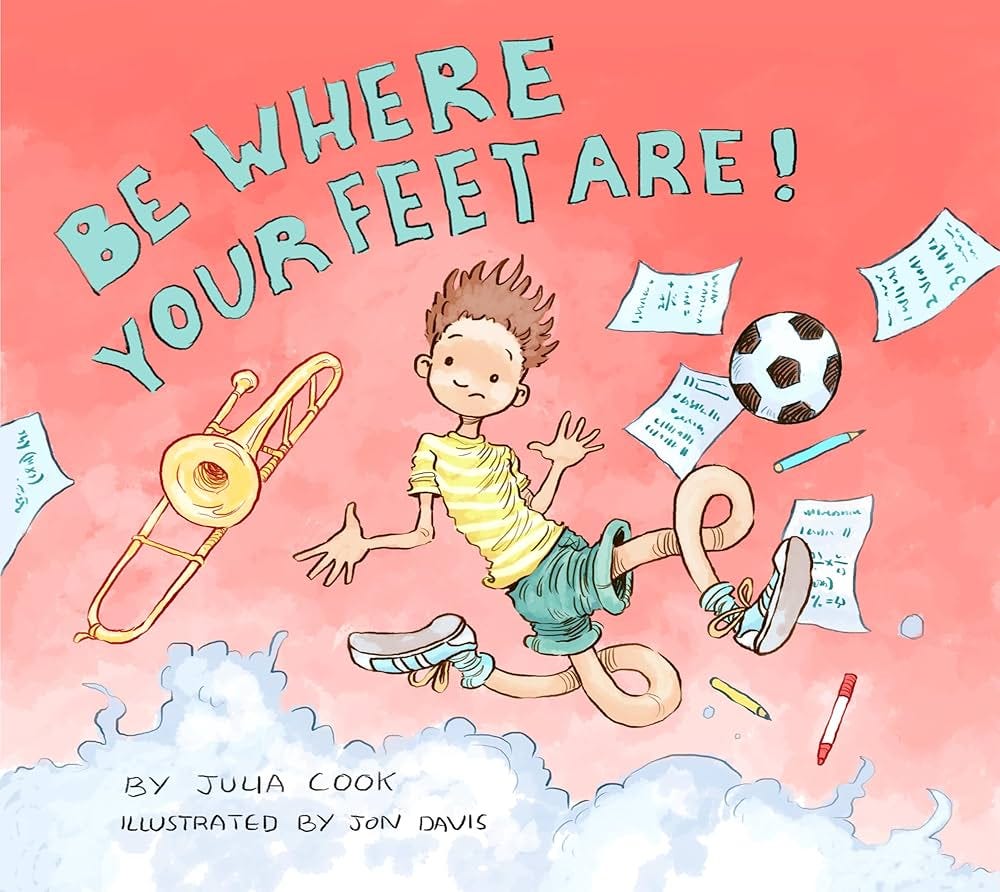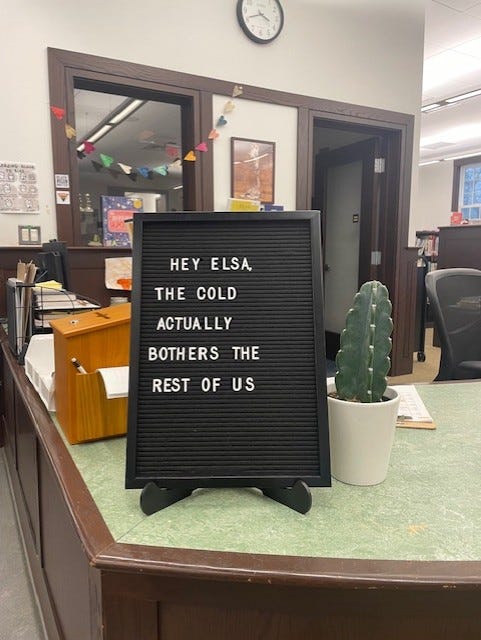Happy February, Moga friends! Love is in the air, and so is the flu, so wash your damn hands! I laughed out loud when I read this on Pinterest. I’ve been spending time on there looking for letterboard ideas for the Fenn library. We have a letterboard on our circulation desk, and each week, we feature a new joke, pun, or silly line. It’s become quite a popular destination for students and faculty alike, so the pressure’s on to find a good one every week. Sadly, this one probably doesn’t make the “library appropriate” cut, but it was worth sharing with all of you!
How are you all doing? January came and went and left behind a trail of change. A new year, a new president, tragic wild fires, wild weather patterns (it’s been snowing in North Carolina!), a devastating plane crash, and of course, the daily hustle of life. With all of this going on in and around our lives, it’s important that we check in with ourselves and each other. If you’ve noticed an increase in anxious or panicky feelings lately, you’re definitely not alone. I’ve felt it too—old feelings creeping back that had been lying dormant. My first instinct is always to get more anxious about feeling anxious (the irony!), but with a regular mindfulness practice, I’ve been able to notice this old pattern and decide to respond differently. This isn’t easy and it doesn’t mean that I don’t fall back into those habitual negative thought patterns, in fact, I had quite a few days where I was feeling pretty shitty, to be honest. But then I thought to myself, lean in, let the feelings be, and then let go. More to come on this…
In thinking about the month of February, it’s hard not to think about Valentine’s Day. Walk into a Marshall’s or TJ Maxx, and you’ll be bombarded with all the reds, pinks, hearts, and candy. And that got me thinking, what’s the best way to truly express love? We could have a debate about this one because I think it really depends on the person—our experiences, personalities, and biological makeup. Have you ever heard of the book The 5 Love Languages by Gary Chapman? It’s a fascinating book about how we prefer to give and receive love, especially in romantic relationships. There’s even a quiz you can take to find your love language (highly recommend!). For me, February has me thinking about love in a different way—love and letting go. Go ahead, roll your eyes at the cliché Hallmark line: “If you love someone, let them go.” But here me out…
One of the key ideas of a mindfulness practice is releasing attachments to control, perfectionism, self-criticism, you name it. By letting go of these, we create space for self-compassion, allowing us to accept who we are right now without judgement. This doesn’t mean we stop striving to improve or pursue our dreams, but I’d argue success comes from really knowing ourselves—our strengths, weaknesses (yes, we all have them!), and what holds us back. Think about it: have you ever performed better at work with a boss who screams at you for every little mistake? I’m guessing not. Yet, we often allow this internal dialogue to exist without even knowing it, criticizing and berating ourselves and wondering why we sometimes turn that same energy on others—whether it’s gossiping about someone at work, snapping at our kids for forgetting their homework (again!), or any number of other situations.
Loving ourselves, and ultimately others, is about noticing these patterns and being willing to let them go. Let go of the need to have control over our flaws, our expectations, or how others perceive us. Go ahead and wear your pajamas to the grocery store if you want (who cares what people might think?)! If you’re a parent, let your kid sleep without a top sheet on their bed (I know it doesn’t look as put together, but who cares?!), let your dog shit on the rug (I’m just kidding, I just wanted to make sure you were still with me, don’t ever let your dog do that!). You get the idea.
This month, I encourage you to check in with yourself with a gentle heart and kind spirit. How can we cultivate a practice of self-love and compassion that starts with us so that we can have the emotional space to extend the same love and kindness to others? Let February remind us that love is about embracing who we are, flaws and all. And also means knowing when to release what no longer serves us. Whether it’s a belief we’ve outgrown, a habit that holds us back, or the pressure to be anything other than ourselves, may we find ways this month to be intentional about the love we give— to both ourselves and others.
Love Letters from Nature
In thinking about this month’s theme of love and letting go, I can’t help but connect it with trust. After all, it’s hard to let go of something if you don’t trust that everything will be OK. And if you’ve ever walked across a frozen pond that’s 100 feet deep in the center, you might know a thing or two about trust! That’s exactly what G and I did last weekend. As an aspiring ice fisherman, he’s been begging us to take him to frozen bodies of water. And he must have caught me on a good day because even though it was in the 20s, I agreed to go. We ventured to Walden Pond, one of my favorite places to visit in the summer, to give ice fishing a try. But I’ve actually never been to Walden in the winter (mainly because I’m hibernating), and I have to admit, even though I couldn’t feel my toes, the magic was still in the air. There were all sorts of activities happening that day: fishing, skating, hiking, sledding, you name it.
As we walked the frozen pond, searching for open fishing holes (because we’re complete amateurs we literally have zero tools except an ice fishing rod), I had to really practice trusting and letting go. Every crack and creak of the ice made me want to panic, but I paused, took a deep breath, and reminded myself to trust that everything would be OK. And Griff? He had an absolute blast. Me? I quickly found that after the first few magical breathes of Walden air, the frozen wind had me dreaming about a warm, cozy spot back at home! After all, practicing presence is a process, right? Sending love from Walden!
Kid Moga
Mindfulness has been on my mind a lot this month, partly because I’ve had the joy of working with two groups of young people, teaching them moga and guiding them to explore what it feels like to be present.
I’ve been working with the CC Varsity boys hockey team once a week, practicing mindfulness together. As an English teacher and librarian, I can’t help but bring a book with me to practice, so I’ve been using one of my favorite books, The Mindful Athlete by George Mumford, to guide our practice. George works with elite athletes to help them get in the zone and find their flow by learning how to stay in the present moment. My goal for these boys is to show them that mindfulness is about paying attention to the here and now, without judgment, and learning to notice when their minds wander so they can gently bring their focus back to the present, using their breath as an anchor. Since mindfulness is also about self-awareness, I ask the boys to share what they notice after each practice. Many of them share that they feel calmer, while others have noticed it’s getting easier to catch their wandering mind or how time seems to slow down during their practice. Seeing those “lightbulb” moments is one of my favorite things—helping them understand that the skill of quiet reflection is something they can always access when they need it. All they have to do is pause, pay attention, and listen.
I’ve also been teaching moga with the squash team at Fenn. They’re an energetic bunch of middle schoolers who lovingly named our group “Varsity Moga.” I enjoy guiding them through specific yoga moves, putting together short flows to some of my favorite yoga songs (think Sittin’ on the Dock of the Bay vibes), and wrapping up with a mindfulness meditation practice. My heart sings when I look out during our meditation practice to see 18 silent and still middle school boys practicing the art of noticing their thoughts and bringing their attention to their breath.
Practicing mindfulness doesn’t have to be complicated or take a lot of time—it can be as simple as taking one intentional breath. I encourage you to share this practice with the young people in your life or try it for yourself. Even just a few minutes can create a meaningful shift. Here’s a simple way to practice mindful breathing:
Find a comfortable position—sitting, lying down, or even standing.
Close your eyes or soften your gaze.
Take a deep breath in through your nose, feeling your belly expand.
Exhale slowly through your mouth, letting your body relax.
Pay attention to your breath, noticing the sensation of air moving in and out.
Repeat for a few breaths or as long as feels good.
Mindfulness is a skill that grows with practice, and the beauty of it is that it’s always available. All it takes is a moment to pause, breathe, and be present.
Mindful Library
There are so many books I’m either reading or itching to dive into that it was tough to decide which ones to highlight this month. If you’ve been following the ALA Youth Book Awards, you know the winners were just announced, and the book world is buzzing with excitement. In the spirit of awards season (and with the Oscars just around the corner), I’m saving many of those titles for March’s newsletter. For now, I’ll share a few books I’ve read this month or have on my “Want to Read” list—I hope some of them spark your interest!
The first book is a children’s picture book called Be Where Your Feet Are by Julia Cook. While parts of it might be a little cheesy, the message is so important. It’s a reminder—for kids and adults alike—about the power of mindfulness and staying present. The story follows a young boy who struggles to focus, often drifting into thoughts about the past or future. With a little guidance, he learns how to “be where his feet are,” grounding himself in the present and discovering how to fully enjoy and engage with the world around him. And there’s a little advice at the end for adults, too!

My colleague recently shared a book with me that I read over winter break called The Other Wes Moore by Wes Moore. She said it was one of her favorite books and tells the true story of two boys with the same name who grew up in similar neighborhoods but led drastically different lives—one becoming a military leader, Rhodes Scholar, and author, and the other ending up in prison. This book explores how choices, environment, and support systems shape our futures, offering a powerful reflection on opportunity and resilience. I saved a quote because I think it perfectly captures the complicated emotions boys experience in their relationships with their mothers: “My relationship with my mother was in a strange place. My desperation for her support was in constant tension with my desperation for independent and freedom. I projected apathy about her feelings, but I wanted nothing more than to make her proud. In other words, I was a teenager, deathly fearful of disappointing her but too prideful to act like it mattered. Now I was afraid this incident might turn my only stalwart support against me.”

I’m a sucker for a good self-help book (as you might have noticed!), so this one quickly landed on my “want to read” list—and even helped inspire this month’s theme. I first heard about it from Mel Robbins on her podcast, which I highly recommend checking out. It’s a short listen, and you might find that the message resonates with you right away, even before picking up the book. The Let Them theory is a mindset shift that challenges the urge to control others’ actions or opinions. Instead of reacting emotionally or trying to change people, it encourages you to let them. At its core, it’s about recognizing that we can’t control others—only our response to them.

Final Thoughts
In the beginning of January, Cam went back to base, this time heading to North Carolina for the School of Infantry. He had loads of luggage to take with him, most of which was uniforms and such. When he arrived in North Carolina, his luggage wasn’t there. He had nothing other than the civilian clothes he was wearing. For some reason, this really stressed me out. Sometimes it’s hard to remember that your little ones aren’t so little anymore, but imagining him being in a new place, especially that place, without what he needed really pulled at my heart strings. I went straight to the Marine parent support Facebook page and started to read similar stories (some of them horror stories of losing and having to replace ALL THE UNIFORMS), which as you can imagine, only fueled my fire. And then I took a step back and remembered Mel Robbins podcast and thought to myself: let them. In this case, let him figure this out. He wasn’t asking for help, and in fact, he was learning a very valuable lesson about planning ahead (make room in that carry-on bag!) and also learned a little about adulting. He spent hours each day on the phone with American Airlines, and a few days later, all his stuff was delivered and all was well.
I don’t think I need to convince you how much I love my kids. I would do anything for them, but I’ve learned that one of the greatest ways to show them love is to trust them—to trust their ability to solve problems and navigate challenges. To let them know that I’ll always be here if they need me, but also to remind them: they’ve got this. True love, whether for others or ourselves, often means releasing control and trusting that things will unfold as they should. So this February, I wish you chocolate hearts, handwritten love notes, and whatever else fills you with joy. Most of all, I wish you a month of giving and receiving love, in all its beautiful, heart-filling forms. ❤️
Sending Love,
Leonor
Leonor is a licensed ELA teacher, Director of the Hammett Ory Library at The Fenn School, and Moga (Mindfulness + Yoga) Practitioner. She is also the mother of three boys and has learned a whole lot from making mistakes and trying again.







Beautiful post! Letting our children figure things out for themselves is the hardest, yet most important lesson!!
Thank you for this! You are awesome ❤️